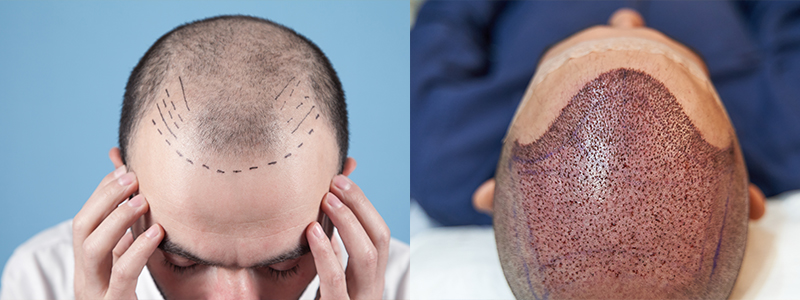Hair Transplant
Hair transplant (or autotransplant) is a surgery that involves the transfer of small areas of scalp or just hair bulbs from an obviously thick area of hair to a hairless or less thick area of hair.
These are, therefore, live, non-atrophied follicles taken from the same patient (this is why it is called an autotransplant).
Neither a transplant from a donor nor the grafting of synthetic bulbs is possible.
Fortunately, in the majority of people affected by androgenetic alopecia, a "crown" of hair remains in the occipital and temporal region, which is available for transplantation as it is resistant to loss even in old age.
Today, hair transplant represents one of the few solutions available in the presence of widespread atrophy of the hair bulbs, typical of those suffering from androgenetic alopecia.
In fact, drugs such as finasteride and minoxidil and the large number of cosmetics and various supplements can produce a certain improvement only in the presence of more or less suffering, but still vital, follicles.
Since the transplanted bulbs retain the typical life cycle of the region of removal (which is genetically resistant to alopecia), hair transplant can be considered a definitive treatment, but not an entirely conclusive one. In fact, it is not able to intervene on the causes that triggered baldness.
It will therefore be the doctor's task to direct each patient towards the treatments and therapies that best suit each individual case.
What is androgenetic alopecia: a quick review
Androgenetic alopecia is a common condition that can affect men and women and is characterized by hair loss.
Androgenetic alopecia has a genetic origin and is due to an excessive response to androgens (hence the name), hormones typically associated with the male sex, but which are actually also present in women (although in smaller quantities).
In androgenetic alopecia, hair loss progresses in a very characteristic way in men and women:
In humans, it starts from the temples and the frontal area; after that, it also affects the vertex area.
With time and the progression of hair loss, the areas without hair meet until the only areas of the head covered by hair are the lateral and occipital areas.
In women, however, androgenetic alopecia affects almost exclusively the vertex area, with the temples, occipital area and frontal area remaining mostly unchanged.
For men, it is the Norwood scale that describes the evolution of androgenetic alopecia and represents a point of reference for diagnosis; for women, however, the equivalent is the Ludwig scale.
Transplant Techniques
Modern hair transplant techniques have improved significantly since the mid-1950s, when the first procedures often resulted in conspicuous scars and unnatural-looking results.
The two most widely adopted transplant techniques today are:
FUT (Follicular Unit Transplant)
Involves taking a strip of scalp from the occipital area (nape) and sectioning it into small grafts containing 1-4 hair follicles.
Provides fairly natural results but can leave scars at the donor site.
FUE (Follicular Unit Extraction)
Involves individually extracting and transplanting hair follicles using specialized instruments.
Includes variations like Micro FUE, which uses smaller instruments for a less invasive procedure without scarring.
Allows for implants to be oriented in the natural direction of hair growth, providing extremely natural results with minimal post-operative issues or permanent scarring.
Performed by experienced professionals, modern hair transplant techniques are effective, minimally invasive, discreet, and more accessible solutions compared to earlier methods.

